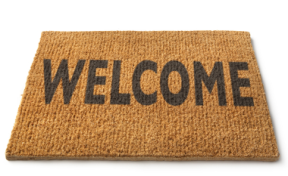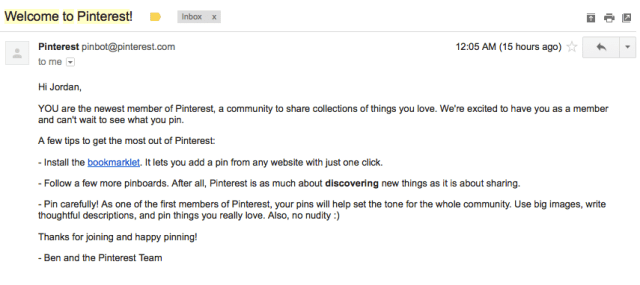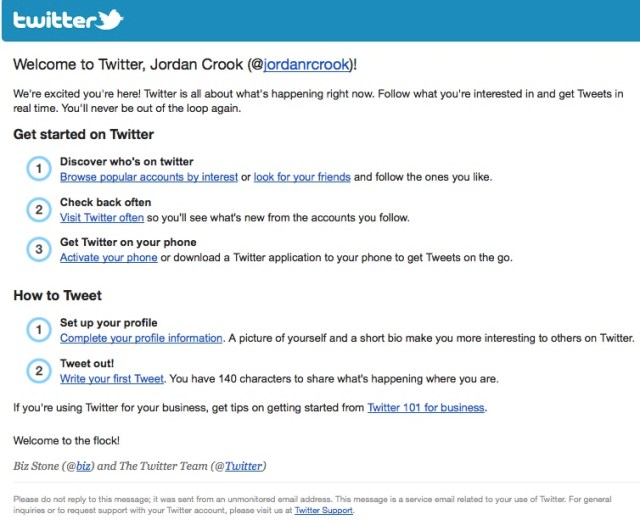
Two days ago, I received an invite to Pinterest. (I know, I’m late.) After signing up, I pretty much ignored the welcome message, just as I do with most services. But last night I decided to get myself caught up after the Crunchies, and started reading through all my unread emails (even the ones from Nigerian royal’s relatives) and found myself actually reading through the Pinterest welcome email, too.
It’s wonderful, and the reason it’s wonderful comes down to just one bullet point:

Welcome messages are important because they’re usually the first point of contact between user and service. Good ones “set the tone” for the relationship the user will have with the service, give them helpful tips on how to get going (and be good at it), and usually have some kind of indication of what the format will be.
Twitter encapsulates these core qualities perfectly in its welcome message. You learn what Twitter is about, are told having a profile pic and information set up gets you more followers, and signs off using @twitter handles.

What Twitter fails to do is tell you that no one gives a damn whether or not your dog needs a walk, or if you’re soooooo tired. And now Twitter is full of people making mundane, useless comments all day long. It’s still a great service, don’t get me wrong. But maybe we wouldn’t be so bombarded by tweets about nothing if someone had said, “And remember, keep it interesting and useful” at the end of the welcome message.
Of course, Twitter’s done nothing wrong in its welcome message. As I said before, it’s actually a great one, especially when compared to ones that just tell you you’ve subscribed.
Looxcie, another great service, is quite complicated. What’s free and what’s paid, how it works, and how to get started can be tricky topics to tackle.
Instead of addressing this right from the get-go, the Looxcie welcome message gives you this:

What’s worse, it asks you for Likes and Follows. This wouldn’t be so bad if we were given some information about what to do, but if all you’re handing me in your opening statement is verification that I’m signed up, please don’t ask me to be a fan. I’m fan enough by using your service. A few buttons at the end of the email would suffice, if that’s really how you want to initially present the service.
Plenty of services go the Twitter route (like Google+, Skype, GroupMe, Dropbox and HipChat), and plenty of services go the Looxcie route (like Beluga and LinkedIn (which basically just asks you to add more information)). Plenty fall in the middle (like Yammer, Heelo and Disqus), offering a very brief, vague idea of what’s going on followed by links to more information.
Where Pinterest separates itself is in recognizing that the service is, when all is said and done, us. Twitter is a smart platform, but what makes it interesting is the users. The same can be said for most services, but instead of looking at what we can do for this or that service, the welcome message focuses on what the service can do for us.
That’s not to say that the welcome message shouldn’t tell us about a service’s features and how it works, but isn’t it just as important to recognize that we have plenty to offer the service.
I think twice about what I pin after reading that message (so far just an old record cover of NSYNC’s first album), which could lead people to pin less. Perhaps, being “picky” about how users use the site could work against Pinterest.
But in my opinion, I feel much more welcomed by Pinterest than all the rest.
Source:http://techcrunch.com/2012/02/04/which-service-has-the-best-welcome-message-hint-pin-carefully/
It’s wonderful, and the reason it’s wonderful comes down to just one bullet point:
Pin carefully! As one of the first members of Pinterest, your pins will help set the tone for the whole community. Use big images, write thoughtful descriptions, and pin things you really love. Also, no nudity

Welcome messages are important because they’re usually the first point of contact between user and service. Good ones “set the tone” for the relationship the user will have with the service, give them helpful tips on how to get going (and be good at it), and usually have some kind of indication of what the format will be.
Twitter encapsulates these core qualities perfectly in its welcome message. You learn what Twitter is about, are told having a profile pic and information set up gets you more followers, and signs off using @twitter handles.

What Twitter fails to do is tell you that no one gives a damn whether or not your dog needs a walk, or if you’re soooooo tired. And now Twitter is full of people making mundane, useless comments all day long. It’s still a great service, don’t get me wrong. But maybe we wouldn’t be so bombarded by tweets about nothing if someone had said, “And remember, keep it interesting and useful” at the end of the welcome message.
Of course, Twitter’s done nothing wrong in its welcome message. As I said before, it’s actually a great one, especially when compared to ones that just tell you you’ve subscribed.
Looxcie, another great service, is quite complicated. What’s free and what’s paid, how it works, and how to get started can be tricky topics to tackle.
Instead of addressing this right from the get-go, the Looxcie welcome message gives you this:

What’s worse, it asks you for Likes and Follows. This wouldn’t be so bad if we were given some information about what to do, but if all you’re handing me in your opening statement is verification that I’m signed up, please don’t ask me to be a fan. I’m fan enough by using your service. A few buttons at the end of the email would suffice, if that’s really how you want to initially present the service.
Plenty of services go the Twitter route (like Google+, Skype, GroupMe, Dropbox and HipChat), and plenty of services go the Looxcie route (like Beluga and LinkedIn (which basically just asks you to add more information)). Plenty fall in the middle (like Yammer, Heelo and Disqus), offering a very brief, vague idea of what’s going on followed by links to more information.
Where Pinterest separates itself is in recognizing that the service is, when all is said and done, us. Twitter is a smart platform, but what makes it interesting is the users. The same can be said for most services, but instead of looking at what we can do for this or that service, the welcome message focuses on what the service can do for us.
That’s not to say that the welcome message shouldn’t tell us about a service’s features and how it works, but isn’t it just as important to recognize that we have plenty to offer the service.
I think twice about what I pin after reading that message (so far just an old record cover of NSYNC’s first album), which could lead people to pin less. Perhaps, being “picky” about how users use the site could work against Pinterest.
But in my opinion, I feel much more welcomed by Pinterest than all the rest.
Source:http://techcrunch.com/2012/02/04/which-service-has-the-best-welcome-message-hint-pin-carefully/

No comments:
Post a Comment